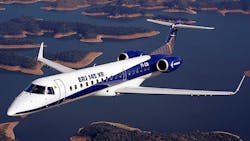Jet builder Embraer released its 20-year forecast (2015-2034) for the Chinese commercial aircraft market, identifying demand for 1,020 new jet aircraft in the 70- to 130-seat segment over that period. That level of demand would represent about 16% of the global market demand for jets in that size range, based on Embraer’s projection of 6,350 deliveries worldwide for 2015-2034.
At current list prices, the value of the Chinese market deliveries is estimated at $300 billion.
“The aviation industry in China will continue to be robust in the foreseeable future,” stated Paulo Cesar Silva, President & CEO, Embraer Commercial Aviation. “We believe China’s aviation industry will keep its momentum during the next 20 years and become the largest single-country market in the world.”
The Embraer Commercial Aviation division presently holds an 80% share of China’ regional aviation market, in particular with its ERJ145 and E190 aircraft. Those jets now serve 120 airports and 400 markets in China, the Brazilian OEM noted.
Embraer specializes in commercial jets for regional market service, with several models for up to 130 passengers. Nearly 900 jets from the ERJ 145 series (designs seating 37, 44, and 50 passengers) have been delivered since their introduction in 1996. The E-Jet family (E170, E175, E190, and E195, introduced in 2004) carries 70 to 130 passengers. Embraer has received over 1,650 firm orders for these designs, and over 1,100 have been delivered.
In 2013, Embraer launched its E-Jets E2 series, three models (E175-E2, E190-E2, E195-E2) for the 70-130-passenger capacity, and these are expected to enter service in 2018-2020.
As for China, through June 30 Embraer has 167 firm orders for commercial jets from Chinese commercial airlines and leasing agencies. Of these, 130 have been delivered to date.
Embraer projected an annual economic growth of 5.6% for the Chinese economy, adding that would drive a 7% annual growth rate for air travel in China over the coming 20 years. That would make China the world’s largest market for commercial air travel.
Moreover, China represents a particular growth opportunity for the OEM because of governmental policies promoting the expansion of domestic air-passenger service. The "One Belt, One Road" policies are intended to improve links between other neighboring countries and China’s various regions by all modes of transportation. In particular, it endorses efforts by regional airlines to introduce new routes and improve local air transportation.
Embraer also sees positive developments in the Chinese central government’s current five-year economic plan, which includes programs to build 70 new airports and to develop plans for 28 others. These projects are being coordinated by the Civil Aviation Administration of China, which is offering incentives up to $160 million/year to regional airlines, to encourage them to introduce new aircraft.
Embraer commented that these efforts will instill an uneven level of air-transport development in the country, with air access for "second- and third-tier cities" seen growing twice as fast as in major cities. Also, air-service expansion in the next two decades will be led by developments in China’s central and western provinces, "where there are sufficient time slots and incentives from local governments," Embraer emphasized.
On the supply side of the forecast, Embraer noted that Chinese regulations covering new air carriers are being relaxed, prompting "a surge in new private airlines." In Western and Central China, it foresees start-up airlines taking advantage of this opportunity to operate from small bases, which would promote greater efficiency and profitability nationwide.
Embraer added that it sees “a more pragmatic trend” among Chinese carriers, noting they are shifting metrics to measure “shareholder value” more than market share, concluding that 'right-sized' aircraft can generate higher revenue and profit per seat, which promises better returns for investors.
“The government’s focus on a new stage of development, combined with the mindset shift to shareholder return in the Chinese airline industry, unveils huge opportunities for regional aviation, which generates enormous demands for jets in the 70 to 130-seat aircraft,” stated Guan Dongyuan, Embraer senior vice president and president of Embraer China.
About the Author
Robert Brooks
Content Director
Robert Brooks has been a business-to-business reporter, writer, editor, and columnist for more than 20 years, specializing in the primary metal and basic manufacturing industries.
